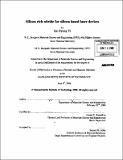Silicon rich nitride for silicon based laser devices
Author(s)
Yi, Jae Hyung
DownloadFull printable version (62.70Mb)
Other Contributors
Massachusetts Institute of Technology. Dept. of Materials Science and Engineering.
Advisor
Lionel C. Kimerling.
Terms of use
Metadata
Show full item recordAbstract
Silicon based light sources, especially laser devices, are the key components required to achieve a complete integrated silicon photonics system. However, the fundamental physical limitation of the silicon material as light emitter and the limited understanding of tli~ excitation mechanism of Er in dielectric media by optical and electrical pumping methods impedes the progress of the research activities in this area. Silicon rich nitride (SRN) has been investigated as a strong candidate for silicon based laser devices. SRN has many advantages over other Si-based materials systems. These advantages include a high electrical injection level at low voltages, a low annealing temperature for Si nanocluster (Si-nc) formation and a large refractive index for strong optical confinement. Strong light emission from localized states in Si-nc embedded in SRN was demonstrated with a PLQE (Photoluminescence Quantum Efficiency) of 7%. This effect was confirmed through several experiments and first principle calculations. Thue Morse aperiodic structures were fabricated with light emitting SRN and SiO2 materials, for the first time. Through the resonance phenomena achieved using this approach an emission enhancement of a factor of 6 was demonstrated experimentally. A sequential annealing technique was investigated to enhance the light emission from the Si-nc based light emitter. Electrical injection was greatly improved with annealing treatments of SRN based devices. In particular, bipolar electrical injection into SRN led to electroluminescence which was comparable to photoluminescence in peak shape and spectral position. Er doped SRN (Er:SRN) was fabricated through a co-sputter technique to achieve light emission at the wavelength of 1.54 [mu]m. (cont.) Energy transfer from SRN td Er was confirmed and shown to have a strong dependence on Si content. Si racetrack resonator structures with a low loss value of 2.5 dB/cm were fabricated through a Local Oxide (LOCOS) process and coupled with an Er:SRN layer to investigate gain behavior. Electrical injection properties into the Er:SRN layer were investigated and the electroluminescent device was fabricated. A detailed discussion on optical and electrical excitation of Er is provided to clarify the difference of the Er excitation mechanisms. A comparison of key simulation parameters used within the two level equations for optical and electrical excitation of Er atoms is provided to explain how the parameters contribute to each excitation mechanism. The most significant differences between the parameters and excitation mechanisms are also explained. Finally a summary of important factors to achieve a silicon based laser is provided and discussed for future investigation based on the experimental data and the investigation presented in this work.
Description
Thesis (Ph. D.)--Massachusetts Institute of Technology, Dept. of Materials Science and Engineering, 2008. Page 214 blank. Includes bibliographical references.
Date issued
2008Department
Massachusetts Institute of Technology. Department of Materials Science and EngineeringPublisher
Massachusetts Institute of Technology
Keywords
Materials Science and Engineering.